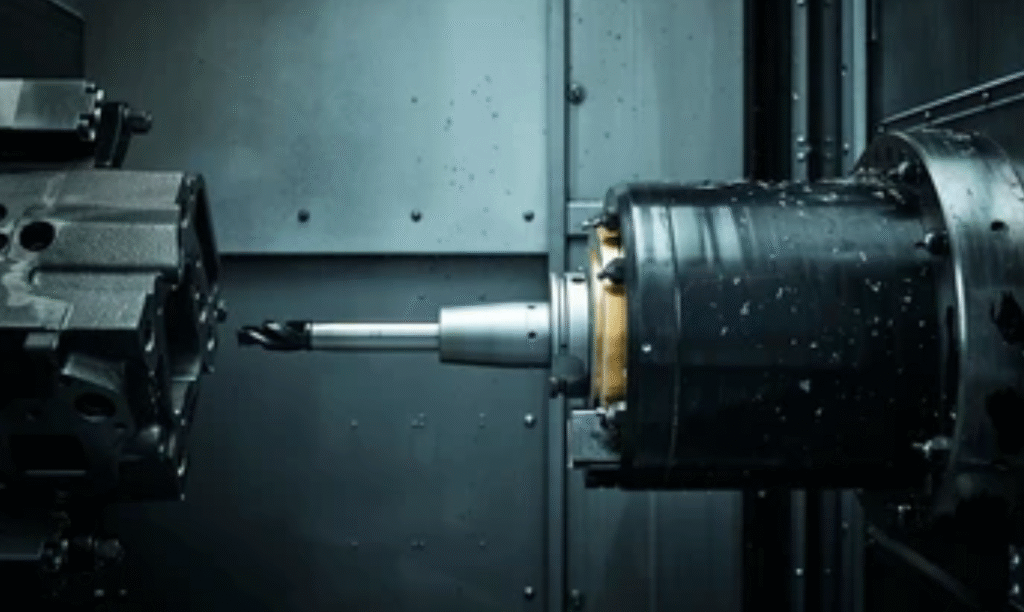Learn everything about plain milling, in terms of process, use, advantages, disadvantages, price, and face milling—a complete guide for beginners and professionals.
Most of the machining operations are performed by using plain milling. It is a highly important operation for machining beginners and aging machinists alike, whether for producing flat surfaces or for precisely shaping materials. In this article, I will take you through the process, types of cutters, materials, advantages, disadvantages, pricing, and safety tips related to plain milling. Let’s get started.

What Is Plain Milling?
Machining process in which a rotating cylindrical cutter mills a flat surface is plain milling, or slab milling. The workpieces moved against the cutter, mounted on a horizontal spindle. It is one of the simplest and most commonly used milling methods intended to manufacture flat and horizontal surfaces.
Unlike contour milling and pocket milling, it attempts to remove material in a smooth, flawless, and speedy manner to produce flat, smooth surfaces. This is widely used in the automotive, aerospace, construction, and tool-making industries.
Plain Milling Process
So, here is the step-by-step method for plain milling

1. Setup
The workpiece is properly set up as the first step in the plain milling process. So, the material is clamped securely onto the milling table such that it is not allowed to move while the cutting operation is taking place. To achieve proper accuracy, dampen vibrations, and protect the workpiece and the machining machine from possible damage, proper clamping is a must.
2. Tool Selection
Before doing the workpiece, it is also important to select the right tool. The milling cutter used is a plain one that depends on the type of material being machined and the surface finish desired. To achieve its best performance, the cutter’s size, tooth configuration, should be and the material should be a match for the project’s requirements.
3. Speed and Feed Setup
When the tool is selected, the machinist must choose the right cutting speed, feed rate, and depth of cut. These workpiece material, cutter material, and required surface finish are dependent parameters. The proper speed and feed setting will get you efficient material removal as well as extend the tool’s life.
4. Cutting
Once the settings of the machine are finalized, it is in the actual cutting phase. In this step, the workpiece is moved steadily into the cutter’s edge while the plain milling cutter provides rotational action in the direction as shown. As they pass, some material is removed, and the rough shape of the final surface begins to take shape.
5. Finishing
The number of finishing passes may vary, depending on the surface finish requirement. During finishing, the feed rate tends to be reduced to provide a smoother and more accurate surface. Secondly, it completes the workpiece, which must have the necessary accuracy in dimensional parameters and aesthetic attributes.
Types of Plain Milling Cutters
Let’s discuss the different types of plain milling cutters we have in market.

1. Heavy-Duty Plain Milling Cutters
These are heavy-duty plain milling cutters intended for roughing operations where a sizable chunk of material has to be milled out. The blades of these cutters are thick and robust, which resist wear and fracture. Machining harder materials like steel is easy with the deeper cuts and heavier feed rates that can be handled without any loss of performance.
2. Light-Duty Plain Milling Cutters
The plain milling cutters are light-duty and are mostly used for finishing operations or machining the softer materials the lines as aluminium and brass. Finer teeth with smaller diameter and thus, higher cutting speeds, with better surface finishing, with this type of cutter. When the material removal rate is not very important and precision and fine quality surfaces are more important, these tend to be preferred.
Plain Milling for Beginners
So, let’s discuss the guide to understand plain milling well at beginner’s scale;
1. Understanding Machine Basics
For beginners, they should first learn about horizontal milling machines and their basic parts. Learning how to operate the machine successfully and without danger of accidents requires an understanding of how the spindle, table, and feed mechanisms work.
2. Safety First
Milling should always be a safe operation. To prevent accidents, new users must wear the appropriate personal protective equipment (PPE), i.e., safety goggles and gloves, and follow all machine operating instructions.
3. Practice Makes Perfect
It begins with softer material like aluminum to help the beginner get more confident cutting out and refine their techniques. They are forgiving to machine and easier to machine than the harder metals, making them a good choice for learning purposes before moving to the harder metals.
4. Monitor Feeds and Speeds
To avoid ruining their work, beginners need to pay close attention to feed rate and spindle speed. The setting of the tool can compromise the finish or cause tool breakage. It is important that these values are adjusted based on the material and cutter type to achieve the same results each time and build good habits early on.
Plain Milling vs. Face Milling
The following table gives a difference between plain milling and face milling;
| Feature | Plain Milling | Face Milling |
| Complexity | Low complexity | Higher complexity |
| Tool Engagement | Uniform across the cutter width | Varies along the cutter face |
| Ease for Beginners | Easier | Slightly complex |
| Accuracy Requirement | Moderate | Very high |
| Chip Evacuation | Simpler | Requires effective chip evacuation |
Plain Milling Pricing
Here are some pricing idea for plain milling pricing;
1. Material Costs
Overall cost is very much driven by the type of material being milled. It is more expensive to obtain and to machine harder materials such as stainless steel or titanium, therefore, the cost also rises both for the materials used and the tools used.
2. Labor Charges
They often require skilled machinists as well as those willing to go through the practice cycles of these complex milling tasks are often highly valued and paid accordingly. Labor cost depends on the operator, their experience, job complexity, and the labor market of a particular region.
3. Tool Wear and Replacement
Tough materials make for grueling work, and the milling tools continue to have to be used over time and then eventually have to be replaced. Repeated cost of frequent cutter replacements is a continuous component of plain milling operations and has to be included in project costing.
4. Machine Time
The milling machine pricing is mainly dependent on the duration the machine is in use. This will result in shipment cost being longer and ultimately higher machine time, which in turn leads to further higher machining cost.
5. Volume Discounts
Volume discounts may be given on high-volume milling jobs. Bulk orders are usually more economical because the per-unit cost can be reduced through setup time and operational overhead spread over more parts.
Common Issues
So, you might have the following issues while dealing with plain milling;
1. Chatter and Vibration
Chatter, wavy or rough surface finish, is one of the most common problems in plain milling. This normally takes place due to poor clamping, tool wear, or high cutting speeds. One could address setup stability and tool condition to resolve this problem.
2. Tool Breakage
Inaccurate cutters for the material will tend to run breakage, and then there is the matter of feeds and speeds not being properly set. Tool failure can quickly strike the workpiece and can suspend operations or safety hazards. This is prevented by selecting appropriate tools and settings.
3. Excessive Heat
When metals are cut without the proper cooling or lubrication, the heat can get so great that the tool wears out and the metal becomes deformed. The use of a suitable coolant and controlling the cutting speed can help control the heat generation during CNC milling.
4. Workpiece Movement
It can also shift if the workpiece is not clamped securely. But this also delays the accuracy of dimensions and exposes the risk of damaging the tool. Before starting the cut, always verify the fixturing first to make sure it is accurate and safe.
Plain Milling Safety
Let’s discuss the plain milling safety measure’s
1. Wear Protective Gear
All milling operations require you to wear the right protective gear. Proper clothing will also limit entanglement, protection from flying chips with safety glasses and gloves on your hands to protect your hands from sharp edges. The chances of being injured are high if protective equipment is skipped.
2. Secure Workpieces Properly
It is very important, before starting the machine, to check if the workpiece attaches to the milling table. The workpiece can move freely during the cutting process, which results in inaccurate machining, tool damage, or even a chance to injure oneself. Stability and precision are ensured by proper fixturing.
3. Avoid Distractions
Milling operations require full concentration. An engineer commits errors because he cannot afford to have a momentary lapse in his attention. Focusing rather than multitasking, and never leaving the machine unattended, are the rules for operators. The risk of injury in the workshop is significantly less.
4. Proper Maintenance
Safe and efficient operation requires regular maintenance of milling machines and tools. Prompt replacement of dull or worn-out cutters and cleaning, lubricating, and inspection of machines to avoid mechanical failures, which could pose safety hazards.
5. Emergency Procedures
Emergency stop procedures and safety switches should be familiar by all operators. However, for an unexpected incident, it’s good to know that it can be shut down quickly to avoid injuries and damage. Machine shop Safety involves emergency preparedness as a key feature.
Applications
Plain milling has many kinds of industrial applications, including:
- Machine Building for bases, tables, and frames.
- Automobile Manufacturing: Producing transmission housings and engine parts.
- Tool expediting aids in the creation of flat surfaces for molds and dies.
- Structural Components: Milling beams, plates, and girders.
- Fabricating desks, shelves, and frames is Metal Furniture Production.
Conclusion
However, plain milling is and will continue to be an indispensable machine method because of its simplicity, versatility, and low cost. If you are just starting your first step in learning the basics or becoming an expert and require perfect flat surfaces on your machining, then plain milling is an important step for you. Proper process, correct selection of tools, and, of course, the appropriate means to ensure safety standards will result in excellent work with plain milling.
FAQs
Q1. What is the principal difference between plain milling and face milling?
The face milling uses the face of the cutter in machining flat surfaces. We can perform plain milling using the periphery of the cutter.
Q2. Is it possible to use plain milling for finishing operations?
Plain milling can provide good surface finishes if there is an appropriate light-duty cutter with fine feed rates.
Q3. What are the common materials we can use for plain milling?
Mild steel, aluminum, cast iron, brass, copper, and plastics are among the common materials.
Q4. What is responsible for chatter in the this milling?
Usually, loose setups, used cutters, or bad feed or speed settings result in chatter.
Q5. Can plain milling be good for beginners?
Absolutely. In terms of the process, this one is one of the easiest milling processes to learn, perfect for beginners in machining.


